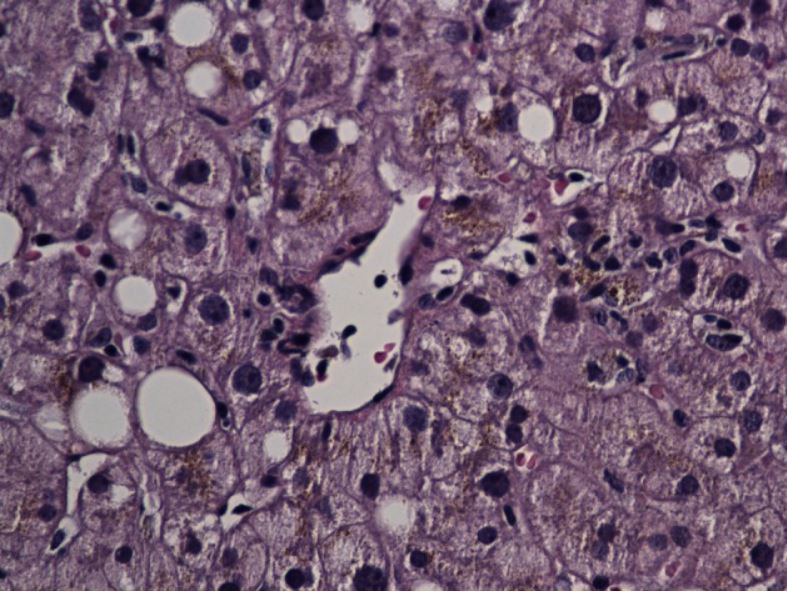Playlist
Show Playlist
Hide Playlist
Acute Liver Failure with Case
-
Slides Gastroenterology 11 Liver Pt1 Hepatitis.pdf
-
Reference List Gastroenterology.pdf
-
Download Lecture Overview
00:02 So now we move on to our next case. 00:05 A 35-year-old man is admitted for new jaundice and confusion. 00:09 A week ago, he was prescribed a course of amoxicillin-clavulanate for an ear infection. 00:15 He has no history of liver disease, he does not drink alcohol or use illicit drugs. 00:21 He takes no other medications or herbal supplements. 00:24 His vitals are normal. 00:26 He is disoriented. 00:28 Physical exam is notable for asterixis, scleral icterus and jaundice. 00:33 His lab show an INR of 2.1, ALT 230 (U/L), AST 420 (U/L), total bili of 8.4 (mg/dL) and creatinine of 1.4 (mg/dL). 00:46 Viral hepatitis serologies, an ANA, anti-smooth muscle antibody and ceruloplasmin are all negative. 00:54 So what is the most likely diagnosis? So, we'll go through some key features here. 01:00 His jaundice and confusion localizes potentially to the hepatobiliary tract. 01:07 He does have a recent drug exposure with his amoxicillin clavulanate but he has no other risk factors for liver injury. 01:16 On physical exam, he does have findings of liver synthetic dysfunction with his asterixis, disorientation and jaundice. 01:26 And these lab findings are somewhat concerning, so we'll discuss what they mean next. 01:33 So, how do we know that this patient has acute liver failure. 01:39 The definition of acute liver failure is quite strict but it is defined by having no prior liver disease, new-onset hepatic encephalopathy, jaundice and coagulopathy. 01:51 You must also have elevated transaminases, so that's your AST and ALT. 01:56 and the entire illness must be there for less than 26 weeks. 02:02 It's important to make this diagnosis, however, because if you diagnose acute liver failure, you should definitely contact a liver transplant center to refer the patient for transplantation evaluation. 02:17 So there are many causes of acute liver failure. 02:22 The first most common cause is viral hepatitis, so all of these infections listed here can lead to this. 02:29 Second common thing is drugs and toxins. 02:32 If you remember that the liver filters out and processes many medications and toxins that we take in, then remember that any of them can cause liver injury. 02:41 So some of the most common ones are listed here. 02:44 Keep in mind that acetaminophen is a very common one. 02:48 Patients may also have shock or ischemic liver leading to acute liver failure. 02:54 They may have alcoholic hepatitis that leads to this. 02:58 Autoimmune hepatitis can lead to this. 03:00 They may have cryptogenic acute liver failure which really just means that we don't know what the cause is. 03:07 And there's a whole slew of other conditions that can lead to this picture as well, listed here. 03:16 So, if we talk specifically about drug-induced liver injury, you should know that this can occur with basically any medication including those that are prescribed, over the counter medications, herbs and supplements. 03:29 So you should always remember to ask a very detailed medication, supplement and herb history from your patients. 03:37 Some common culprits that you may encounter are acetaminophen, antibiotics, antiepileptics, NSAIDs which are quite common over the counter and antituberculosis drugs. 03:54 So, patients with drug-induced liver injury or DILI, can present with either a mild liver injury which can be either hepatocellular or cholestatic or they may present with severe acute liver failure. 04:08 So treatment consist of offering supportive care, stopping any offending drugs that could cause this clinical picture and always remember, if you make this diagnosis of acute liver failure, that patient must be referred to a liver transplantation center for evaluation. 04:26 So now, let's return to our case. 04:29 A 35-year-old man is admitted for a new jaundice and confusion. 04:33 He does have a recent drug exposure with prior antibiotics. 04:37 No other risk factors for acute liver injury. 04:41 And on physical exam, he does have evidence of liver synthetic dysfunction, plus now if we look at all of his labs, we now know that his labs with his transaminase elevation, his coagulopathy with an INR of 2.1 and a bilirubin elevated, is all consistent with acute liver failure. 05:01 So the most likely diagnosis here is acute liver failure from drug-induced liver injury. 05:06 He should be treated with supportive care and referred to a liver transplantation center. 05:13 Thank you very much for your attention.
About the Lecture
The lecture Acute Liver Failure with Case by Kelley Chuang, MD is from the course Disorders of the Hepatobiliary Tract.
Included Quiz Questions
Which of the following is most likely to result in acute liver failure?
- Acetaminophen toxicity
- Hemochromatosis
- Primary biliary cirrhosis
- Primary sclerosing cholangitis
- Hepatic cyst
Which of the following describes the best course of action for the management of acute liver failure?
- Supportive care and referral to a liver transplant center for evaluation
- Liver biopsy
- Endoscopy
- Paracentesis
- Colonoscopy
Which of the following medications can cause acute liver failure?
- Acetaminophen
- Acetylcysteine
- Lactulose
- Penicillamine
- Rifaximin
Customer reviews
5,0 of 5 stars
| 5 Stars |
|
1 |
| 4 Stars |
|
0 |
| 3 Stars |
|
0 |
| 2 Stars |
|
0 |
| 1 Star |
|
0 |
Great format. Inclusion of lab findings and correlation to clinical presentation is so useful.




